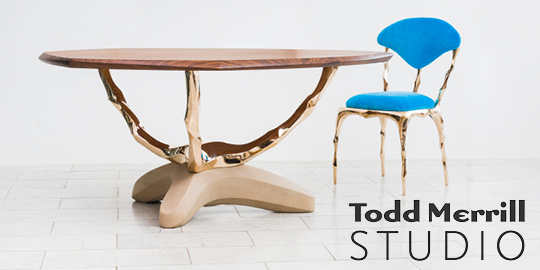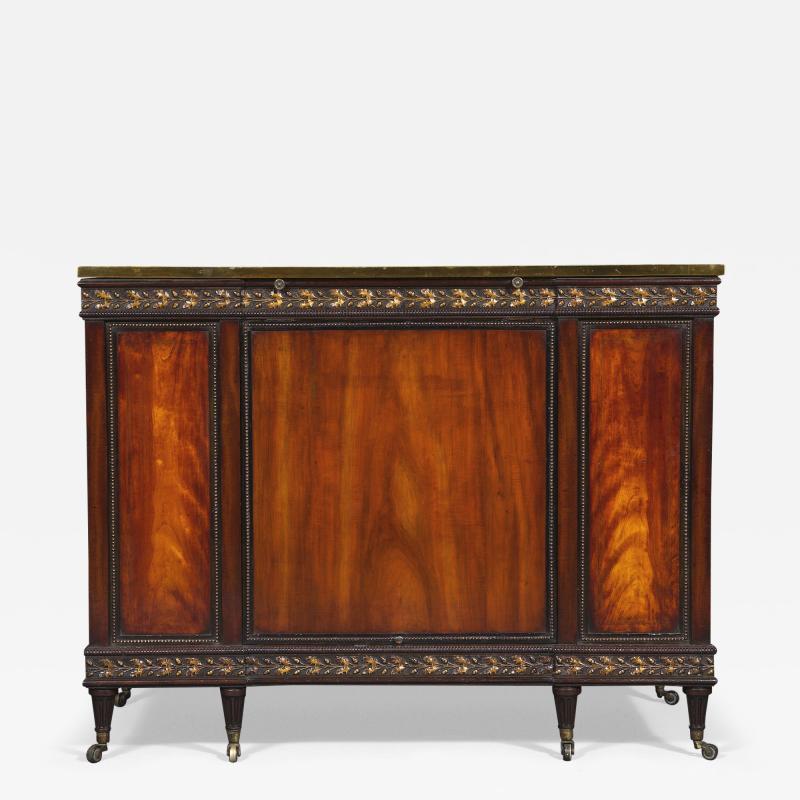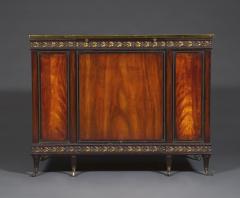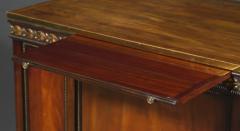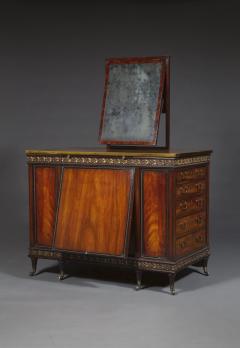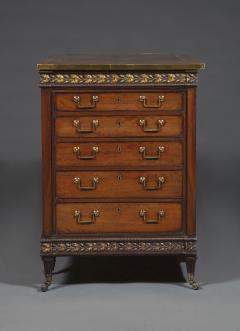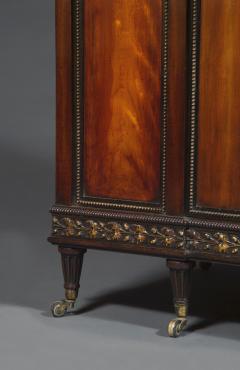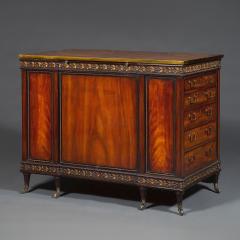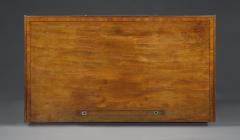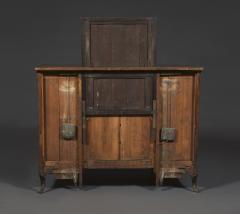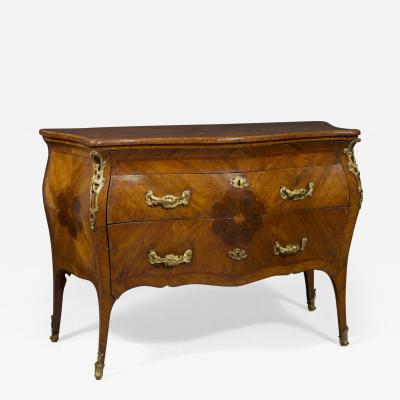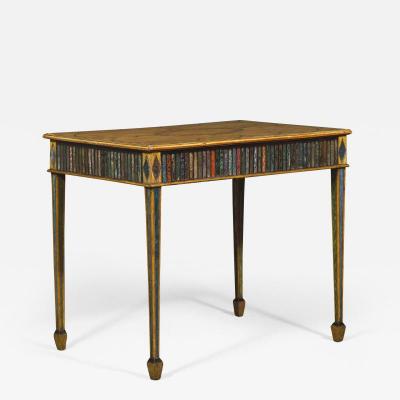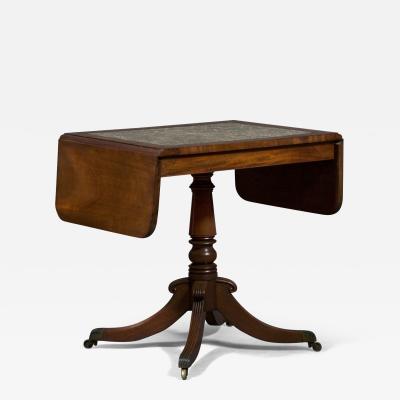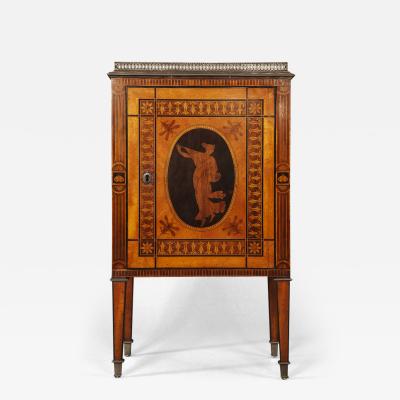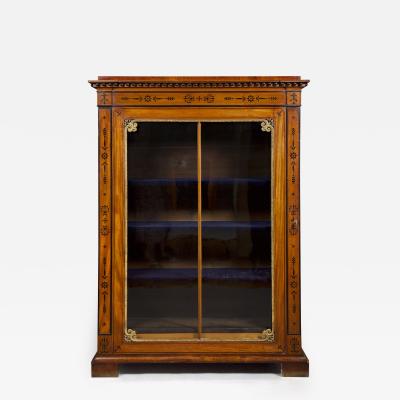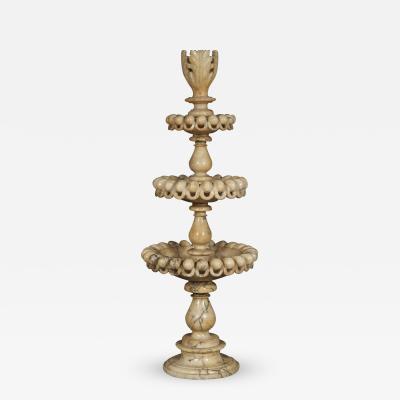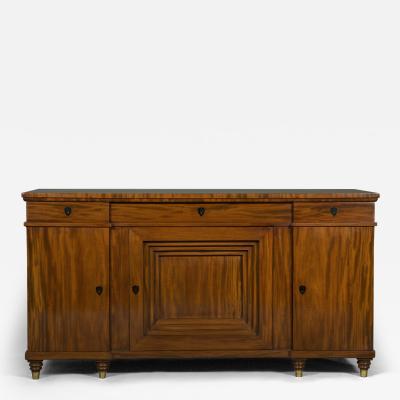A GEORGE III MAHOGANY AND SATIN BIRCH COMMODE
-
Description
A GEORGE III MAHOGANY AND SATIN BIRCH COMMODE IN THE FRENCH TASTE OF MOST UNUSUAL CONFIGURATION AND WITH MECHANICAL VANITY FUNCTION
English. Late Eighteenth Or Early Nineteenth Century.
Measurements
Width: 47 1/2” (120.6 cm); Height: 36 3/4” (93.3 cm); Height including mirror: 64” (162.5 cm); Depth: 26 5/8” (67.6 cm).
Research
Of mahogany, satin birch(?), ebony, gilt brass and gilt composition. The brass bound rectangular cross banded top with concealed rising sash weighted ratcheted mirror to rear operated by two brass flush ring pull handles. The slightly inverted break fronted frieze with continuous band of gilt composition repeating acorn and oak leaf relief pattern decoration. Above the frieze is concealed and ebony strung slide with two brass knob handles. The facade is configured as three rectangular satin birch panels edged with gilt composition pearl beading set on to a ebonized raised band. The central panel with small replaced knob at center bottom which when pulled activates a ratcheting mechanism. The stepped lower frieze also with gilt composition acorn and oak leaf pattern decoration below a knulled molding. Each of the sides is filled with banks of five graduated drawers each set with paired ‘Carlton House drop’ handles. The whole raised on eight circular tapering fluted legs terminating in brass casters, two of which are original and four old replacements. Two missing casters replaced to the rear (not visible). The central panel of the facade may be an extremely old replacement, swapped from a mirror glass panel.
Published:
Joy, Edward T. English Furniture 1800–1851. London: Ward Lock Limited, 1988). 26.
The particular form of austere, geometric neoclassicism observable in the present commode represents a logical reaction against the preceding florid and curvaceous rococo style. Although this remarkably configured piece is of certain English make, it owes a strong design debt to late Louis XVI furniture, in particular the work of royal ébénistes such as Adam Weisweiler, Henri Reisner and David Roentgen, who supplied masterpieces to the French court. The austere Late Louis XVI style which is generally know as ‘goût grec’ is characterized by clean unadorned exacting proportions with expanses of mahogany trimmed with gilt bronze moldings. Because the surfaces are undecorated with marquetry or sculpted mounts, the finest cuts of mahogany were demanded. In the case of Roentgen, many of his commissions incorporated ingenious mechanical devises, as does the present commode. The popularity of mechanical furniture in the nineteenth century from leading makers like Sheraton and Gillows allowed for greater convenience and flexibility when it came to the size and function of a room, and graced finest houses of the early part of the decade. One possible candidate for ownership, with both the sartorial preoccupation and associated symbolism of the present piece, is Admiral Lord Horatio Nelson (1758–1805), the most famous British admiral of the Napoleonic Wars, who delivered victory to the nation at the Battle of Trafalgar.
Full research report available on request. -
More Information
Period: 18th Century Condition: Good. Styles / Movements: Traditional, George III Dealer Reference #: 11624 Incollect Reference #: 725940 -
Dimensions
W. 47.5 in; H. 36.75 in; D. 26.625 in; W. 120.65 cm; H. 93.35 cm; D. 67.63 cm;
Message from Seller:
Carlton Hobbs, LLC specializes in the acquisition, conservation, and research of 17th to 19th century British and Continental furniture and works of art, with a focus on pieces of exceptional merit, including royal and aristocratic provenance. For inquiries, contact 212.423.9000 or email stefanie@carltonhobbs.com.





